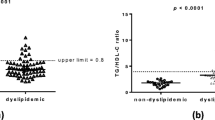Abstract
Cardiovascular disease is a major cause of death in patients with systemic lupus erythematosus (SLE) especially during the late phase of the disease. This study was conducted to evaluate B-type natriuretic peptide (BNP) levels in female SLE patients without cardiac symptoms and to investigate whether BNP levels correlated with echocardiographic findings. We studied 59 women with SLE and 33 healthy women. SLE patients with history of cardiac disease, diabetes mellitus, hypertension, and other inflammatory diseases were excluded from the study. All subjects had a complete history and physical examination. Overall disease activity assessment in SLE patients at the time of the study were derived by calculation of SLE disease activity index (SLEDAI). BNP levels were determined, and transthoracic echocardiography were performed in all subjects. There was no difference between SLE patients and controls in terms of age, blood pressure, smoking status, plasma glucose, creatinine levels, and lipid profiles. Nine patients had SLEDAI score greater than 5. All subjects had an EF greater than 55%. Diastolic dysfunction was more frequent in lupus patients than in controls (15 [25.4%] vs. 2 [6%]; p = 0.022). BNP levels of SLE patients were significantly higher than controls (median 17.9 range [5–211] pg/ml vs. median 14.7 range [5–39.7] pg/ml; p = 0.033). Twenty-seven of the SLE patients (46%) and seven of the controls (21%) had BNP levels greater than or equal to 20 pg/ml (p = 0.019). There were no differences in BNP levels of SLE patients with and without diastolic dysfunction (median 17.8 range [5–117] pg/ml vs. median 18.5 range [5–211] pg/mL; p = NS). BNP levels were positively correlated with left atrium diameter (r 2 = 0.39, p = 0.001). BNP levels did not correlate with erythrocyte sedimentation rate/C-reactive protein levels, SLEDAI scores, total steroid dosage used, or other echocardigraphic parameters. BNP levels were increased in female SLE patients without cardiac symptoms as compared to healthy controls. Although none of the SLE patients in our study had clinical signs of ischemic heart disease, increased levels of BNP in SLE patients might be a reflection of a ischemic myocardial tissue.

Similar content being viewed by others
References
Wajed J et al (2004) Prevention of cardiovascular disease in systemic lupus erythematosus-proposed guidelines for risk factor management. Rheumatology 43(1):7–12
D’Cruz DP (2006) Systemic lupus erythematosus. BMJ 332(7546):890–894
Salmon JE, Roman MJ (2001) Accelerated atherosclerosis in systemic lupus erythematosus: implications for patient management. Curr Opin Rheumatol 13(5):341–344
Weber M, Hamm C (2006) Role of B-type natriuretic peptide (BNP) and NT-proBNP in clinical routine. Heart 92(6):843–849
Wang TJ et al (2004) Plasma natriuretic peptide levels and the risk of cardiovascular events and death. N Engl J Med 350(7):655–663
Harney SM et al (2006) Brain natriuretic peptide is a potentially useful screening tool for the detection of cardiovascular disease in patients with rheumatoid arthritis. Ann Rheum Dis 65(1):136
Tan EM et al (1982) The 1982 revised criteria for the classification of systemic lupus erythematosus. Arthritis Rheum 25(11):1271–1277
Gladman DD, Ibanez D, Urowitz MB (2002) Systemic lupus erythematosus disease activity index 2000. J Rheumatol 29(2):288–291
Kalke S et al (1998) Echocardiography in systemic lupus erythematosus. Lupus 7(8):540–544
Toubi E et al (2000) The benefit of combining hydroxychloroquine with quinacrine in the treatment of SLE patients. Lupus 9(2):92–95
Dao Q et al (2001) Utility of B-type natriuretic peptide in the diagnosis of congestive heart failure in an urgent-care setting. J Am Coll Cardiol 37(2):379–385
Lubien E et al (2002) Utility of B-natriuretic peptide in detecting diastolic dysfunction: comparison with Doppler velocity recordings. Circulation 105(5):595–601
McCullough PA (2004) B-type natriuretic peptide and its clinical implications in heart failure. Am Heart Hosp J 2(1):26–33
Uusimaa P et al (2004) Plasma B-type natriuretic peptide reflects left ventricular hypertrophy and diastolic function in hypertension. Int J Cardiol 97(2):251–256
Bhalla MA et al (2004) Prognostic role of B-type natriuretic peptide levels in patients with type 2 diabetes mellitus. J Am Coll Cardiol 44(5):1047–1052
Sasson Z et al (1992) Impairment of left ventricular diastolic function in systemic lupus erythematosus. Am J Cardiol 69(19):1629–1634
Fujimoto S et al (1994) Doppler echocardiographic assessment of left ventricular diastolic function in patients with systemic lupus erythematosus. Cardiology 85(3–4):267–272
Murakami Y et al (2002) New insights into the mechanism of the elevation of plasma brain natriuretic polypeptide levels in patients with left ventricular hypertrophy. Can J Cardiol 18(12):1294–1300
Schillaci O et al (1999) Technetium-99m sestamibi single-photon emission tomography detects subclinical myocardial perfusion abnormalities in patients with systemic lupus erythematosus. Eur J Nucl Med 26(7):713–717
Rana BS et al (2006) B-type Natriuretic Peptide can detect silent myocardial ischaemia in asymptomatic type II diabetic patients. Heart 92:916–920
Hopkins WE et al (2004) Increased atrial and brain natriuretic peptides in adults with cyanotic congenital heart disease: enhanced understanding of the relationship between hypoxia and natriuretic peptide secretion. Circulation 109(23):2872–2877
Author information
Authors and Affiliations
Corresponding author
Rights and permissions
About this article
Cite this article
Karadag, O., Calguneri, M., Yavuz, B. et al. B-type natriuretic peptide (BNP) levels in female systemic lupus erythematosus patients: what is the clinical significance?. Clin Rheumatol 26, 1701–1704 (2007). https://doi.org/10.1007/s10067-007-0575-4
Received:
Accepted:
Published:
Issue Date:
DOI: https://doi.org/10.1007/s10067-007-0575-4




